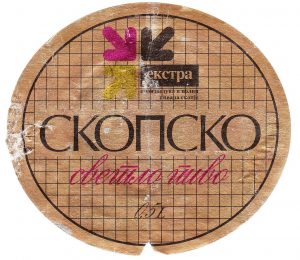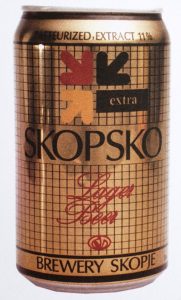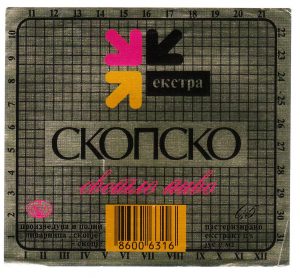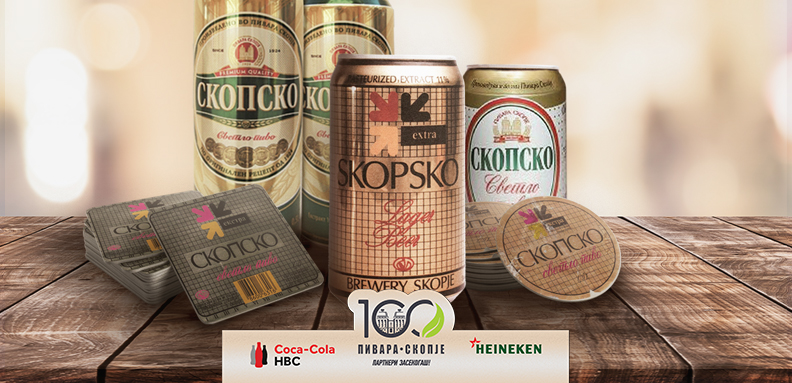
THE GOLDEN SKOPSKO CAN — THE REVOLUTIONARY DESIGN THAT MARKED THE 90s
Poured by:
Vasilka Dimitrovska, M.Sc
Alexander Madzovski
HAEMUS – Center for scientific research and promotion of culture
Marketing experts often know how to say: “Design sells!” The unique visual presentation of a quality product has always been a significant part of the overall image consumers will get of it, and this is especially true for beer. The shape and type of the packaging, together with the beer label, represents a kind of identity card and an association that is directly related to the taste of the favorite beer, and over time this segment of the production process becomes part of contemporary fine art. When you see a green can with a red pentagram in the refrigerator at the neighborhood market, you don’t even have to read the label — you immediately recognize the beer of the Heineken company, whose family also includes Pivara Skopje since 1998.
And precisely in the late 80s and early 90s, cans became a hit in these areas and Pivara Skopje can boast about being a pioneer in popularizing this type of packaging, which is already considered part of the popular art of the 20th and 21st century. The can leaves more room and freedom for artistic expression than traditional glass packaging with a label. The entire 360-degree radius is available to the artist, opening up a variety of possibilities for creative design, so the can represents another medium for works of art, which future generations will value just as we value the figural representations of ancient ceramic vessels today. The only problem is that modern packaging, unlike ancient ceramics, is recycled. A reason to appreciate collectors more, even of seemingly trivial things like labels and beer cans.
Over the decades, the labels of SKOPSKO experienced various transformations, but that period of the late eighties and early nineties will be marked by the recognizable “golden label” of the famous Macedonian artist, graphic artist and caricaturist Vladimir Borojevic. The label, which Borojevic designed in 1988, is a technical grid containing three rounded arrows: pink, yellow, black, as well as the name of the product in Cyrillic. In the label, the dominant colors are used, green which alludes to the traditional color of the glass (bottle) and gold which reflects the quality and maturity of the grains from which the beer is made. After the company started packaging its products in cans in the 90s, the gold label will also be found on the can, which gets the recognizable golden color. The appearance of this can is also significant because of another curiosity.
“I remember Borojevic’s golden can. It was a small revolution in graphic design. It was something totally new, it was gold and I think it is the first metallic label in Macedonia that was made on a computer.” These words of Nebojsa Gelevski, a proven Macedonian graphic designer of the newer generation, are just another confirmation of the historical value of the “golden can “.
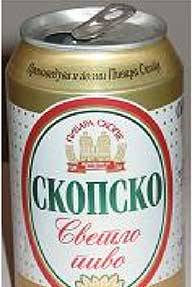 In 1992, the company will redesign its logo, so it will appear on the following editions of the golden can. And in the following years, the color of the can and label of Skopje beer remains recognizable. With a graphic redesign that has been carefully selected and characterizes the already built im
In 1992, the company will redesign its logo, so it will appear on the following editions of the golden can. And in the following years, the color of the can and label of Skopje beer remains recognizable. With a graphic redesign that has been carefully selected and characterizes the already built im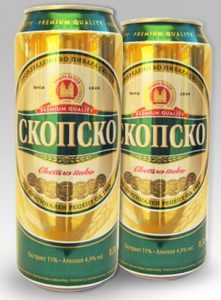 age of the brand, in the 2012 edition the complete design of the label and its elements have been transferred to the design of the cans.
age of the brand, in the 2012 edition the complete design of the label and its elements have been transferred to the design of the cans.
The dominant colors are gold, which reflects the quality and maturity of the grains from which the beer is made, and green, which evokes the traditional color of the glass (bottle). The name of the product is written in the middle on an illustration of a green ribbon in a handwritten Cyrillic font. Under it are presented the seven “Monde Selection” quality gold medals that SKOPSKO has received over the years as well-deserved recognition for its top quality. In the following years, the SKOPSKO can will appear in various editions, following the appearance of the various aromas of the distinctive beer, but the “golden can” remains as an emblem of the 90s, the can that revolutionized the design.
The text is adapted and reworked from the original scientific research project of HAEMUS entitled “Study on the history of Parnata Pivara Skopje”, commissioned and supported by Pivara Skopje.
Photo: Archives of Pivara Skopje, private collectors.
Archival sources: NUB “St. Kliment Ohridski” – Skopje, DARMS – department Skopje (Archive of the City of Skopje), Archive of the Skopje Brewery.







